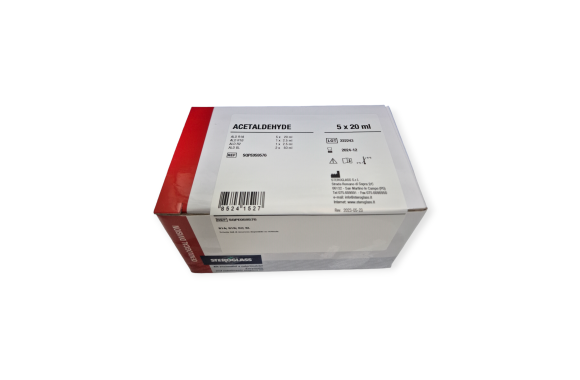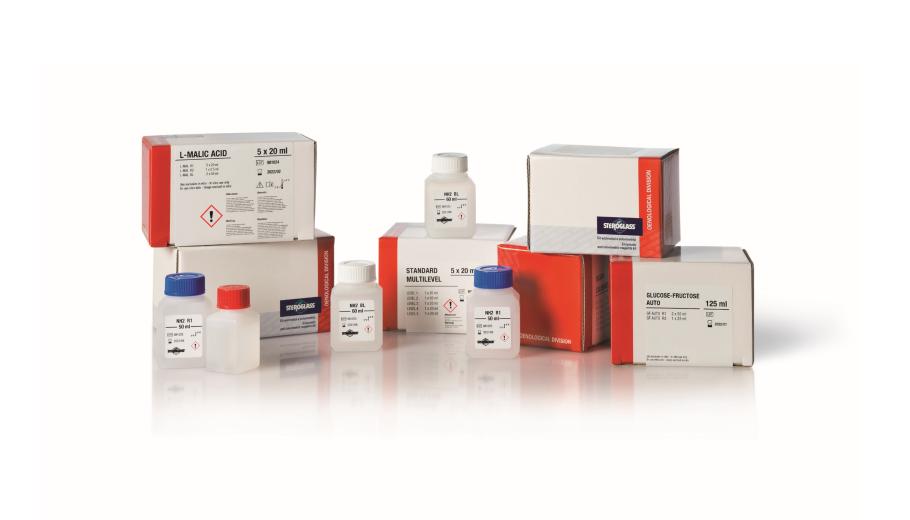ACETALDEHYDE KIT
Contact our expert for more informations.

Acetaldehyde is predominantly produced by yeasts during alcoholic fermentation and serves as a precursor to ethyl alcohol. Additionally, it can accumulate due to the metabolic activity of other microorganisms, but mainly through the chemical oxidation of ethanol during the storage of wines (especially in wooden barrels), making it a marker of the oxidative state of wines. Acetaldehyde, or ethanal, influences the color of wines as it participates in the formation of the “ethyl bridge” (chemical bond) between tannins and anthocyanins and tends to bind to sulfur dioxide, causing a decrease in the level of free sulfur dioxide. Therefore, its determination is essential for the addition of sulfur dioxide (64 mg of SO2 combine with 44 mg of acetaldehyde), which prevents the oxidation of ethanol first to ethanal and then to acetic acid. The concentration of acetaldehyde in wine ranges from 10 to 100 mg/l; this substance is characterized by a pronounced aroma of browned green apple.
Technical features
ADVANTAGES
READY TO USE: Liquid and easy to use.
PRECISION AND SPECIFICITY: Characterized by high specificity, they provide accurate and repeatable data.
LOW COSTS AND LONG SHELF LIFE: Minimal cost per test and a long shelf life (average 24 months).
FAST ANALYSIS: Allow for quick and reliable results (up to 300 tests/hour), especially when used with automated instruments like our HYPERLAB series analyzers.
SIMPLE AND ECONOMIC CALIBRATION: It is possible to use single-method and/or multi-parametric calibration/verification standards. The determination of the Blank is performed automatically every 12 hours with the Hyperlab analyzers.
METHODS APPROVED BY INTERNATIONAL STANDARDS: Numerous enzymatic methods have been approved and validated by international organizations such as:
ISO (International Standardization Organization)
AOAC (American Association of Analytical Chemists)
IFU (International Federation of Fruit Juice Producers)
OIV (International Wine Office)
IDF (International Dairy Federation)
EBC (European Brewery Convention) and many others.
STERGLASS ENZYMATIC AND COLORIMETRIC KITS
Enzymatic and colorimetric kits are widely used in quality control for the main analytical determinations of a variety of food products such as fruit juices, wine, beer, dairy products, eggs, meat, and for the monitoring of fermentation processes carried out by microorganisms for the determination of sugars, organic acids, and other components such as sulfites, phenolic compounds, and metals.
Based on high-quality purified enzymes, enzymatic analysis allows for precise, highly accurate, and repeatable measurements, even in complex matrices. The absorbance variation, measured spectrophotometrically as a result of enzymatic transformations, is closely correlated with the concentration of the various analytes sought.
Industries
Applications
Product codes
| Steroglass code | Description | analysis number |
|---|---|---|
| SQPE059576 | kit 5x20ml |
manual 50/100 automatic 200/300 |
